[English] 日本語
 Yorodumi
Yorodumi- PDB-1m18: LIGAND BINDING ALTERS THE STRUCTURE AND DYNAMICS OF NUCLEOSOMAL DNA -
+ Open data
Open data
- Basic information
Basic information
| Entry | Database: PDB / ID: 1m18 | ||||||
|---|---|---|---|---|---|---|---|
| Title | LIGAND BINDING ALTERS THE STRUCTURE AND DYNAMICS OF NUCLEOSOMAL DNA | ||||||
 Components Components |
| ||||||
 Keywords Keywords | STRUCTURAL PROTEIN/DNA / NUCLEOSOME / CHROMATIN / HISTONE / PYRROLE-IMIDAZOLE POLYAMIDE / DNA REGOGNITION / CHROMATIN REMODELING / STRUCTURAL PROTEIN-DNA COMPLEX | ||||||
| Function / homology |  Function and homology information Function and homology informationchromatin organization => GO:0006325 / chromatin organization => GO:0006325 / DNA replication-dependent chromatin assembly / nuclear chromosome / negative regulation of megakaryocyte differentiation / protein localization to CENP-A containing chromatin / CENP-A containing nucleosome / Packaging Of Telomere Ends / Recognition and association of DNA glycosylase with site containing an affected purine / Cleavage of the damaged purine ...chromatin organization => GO:0006325 / chromatin organization => GO:0006325 / DNA replication-dependent chromatin assembly / nuclear chromosome / negative regulation of megakaryocyte differentiation / protein localization to CENP-A containing chromatin / CENP-A containing nucleosome / Packaging Of Telomere Ends / Recognition and association of DNA glycosylase with site containing an affected purine / Cleavage of the damaged purine / Deposition of new CENPA-containing nucleosomes at the centromere / telomere organization / Recognition and association of DNA glycosylase with site containing an affected pyrimidine / Cleavage of the damaged pyrimidine / RNA Polymerase I Promoter Opening / Inhibition of DNA recombination at telomere / Assembly of the ORC complex at the origin of replication / Meiotic synapsis / SUMOylation of chromatin organization proteins / DNA methylation / Condensation of Prophase Chromosomes / SIRT1 negatively regulates rRNA expression / HCMV Late Events / ERCC6 (CSB) and EHMT2 (G9a) positively regulate rRNA expression / PRC2 methylates histones and DNA / Defective pyroptosis / HDACs deacetylate histones / Nonhomologous End-Joining (NHEJ) / RNA Polymerase I Promoter Escape / DNA-templated transcription initiation / Transcriptional regulation by small RNAs / Formation of the beta-catenin:TCF transactivating complex / Activated PKN1 stimulates transcription of AR (androgen receptor) regulated genes KLK2 and KLK3 / RUNX1 regulates genes involved in megakaryocyte differentiation and platelet function / HDMs demethylate histones / G2/M DNA damage checkpoint / NoRC negatively regulates rRNA expression / B-WICH complex positively regulates rRNA expression / PKMTs methylate histone lysines / DNA Damage/Telomere Stress Induced Senescence / Pre-NOTCH Transcription and Translation / Meiotic recombination / Activation of anterior HOX genes in hindbrain development during early embryogenesis / RMTs methylate histone arginines / Transcriptional regulation of granulopoiesis / HCMV Early Events / structural constituent of chromatin / heterochromatin formation / nucleosome / nucleosome assembly / Recruitment and ATM-mediated phosphorylation of repair and signaling proteins at DNA double strand breaks / HATs acetylate histones / RUNX1 regulates transcription of genes involved in differentiation of HSCs / Processing of DNA double-strand break ends / Senescence-Associated Secretory Phenotype (SASP) / Oxidative Stress Induced Senescence / Estrogen-dependent gene expression / chromosome, telomeric region / Amyloid fiber formation / protein heterodimerization activity / protein domain specific binding / protein-containing complex / DNA binding / RNA binding / extracellular exosome / extracellular region / nucleoplasm / nucleus / membrane Similarity search - Function | ||||||
| Biological species | |||||||
| Method |  X-RAY DIFFRACTION / X-RAY DIFFRACTION /  SYNCHROTRON / SYNCHROTRON /  MOLECULAR REPLACEMENT / Resolution: 2.45 Å MOLECULAR REPLACEMENT / Resolution: 2.45 Å | ||||||
 Authors Authors | Suto, R.K. / Edayathumangalam, R.S. / White, C.L. / Melander, C. / Gottesfeld, J.M. / Dervan, P.B. / Luger, K. | ||||||
 Citation Citation |  Journal: J.Mol.Biol. / Year: 2003 Journal: J.Mol.Biol. / Year: 2003Title: Crystal Structures of Nucleosome Core Particles in Complex with Minor Groove DNA-binding Ligands Authors: Suto, R.K. / Edayathumangalam, R.S. / White, C.L. / Melander, C. / Gottesfeld, J.M. / Dervan, P.B. / Luger, K. | ||||||
| History |
|
- Structure visualization
Structure visualization
| Structure viewer | Molecule:  Molmil Molmil Jmol/JSmol Jmol/JSmol |
|---|
- Downloads & links
Downloads & links
- Download
Download
| PDBx/mmCIF format |  1m18.cif.gz 1m18.cif.gz | 339.4 KB | Display |  PDBx/mmCIF format PDBx/mmCIF format |
|---|---|---|---|---|
| PDB format |  pdb1m18.ent.gz pdb1m18.ent.gz | 256.8 KB | Display |  PDB format PDB format |
| PDBx/mmJSON format |  1m18.json.gz 1m18.json.gz | Tree view |  PDBx/mmJSON format PDBx/mmJSON format | |
| Others |  Other downloads Other downloads |
-Validation report
| Summary document |  1m18_validation.pdf.gz 1m18_validation.pdf.gz | 558.7 KB | Display |  wwPDB validaton report wwPDB validaton report |
|---|---|---|---|---|
| Full document |  1m18_full_validation.pdf.gz 1m18_full_validation.pdf.gz | 598.4 KB | Display | |
| Data in XML |  1m18_validation.xml.gz 1m18_validation.xml.gz | 25.3 KB | Display | |
| Data in CIF |  1m18_validation.cif.gz 1m18_validation.cif.gz | 41.3 KB | Display | |
| Arichive directory |  https://data.pdbj.org/pub/pdb/validation_reports/m1/1m18 https://data.pdbj.org/pub/pdb/validation_reports/m1/1m18 ftp://data.pdbj.org/pub/pdb/validation_reports/m1/1m18 ftp://data.pdbj.org/pub/pdb/validation_reports/m1/1m18 | HTTPS FTP |
-Related structure data
| Related structure data | 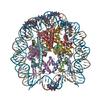 1m19C 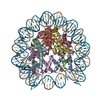 1m1aC  1aoiS S: Starting model for refinement C: citing same article ( |
|---|---|
| Similar structure data |
- Links
Links
- Assembly
Assembly
| Deposited unit | 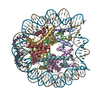
| ||||||||
|---|---|---|---|---|---|---|---|---|---|
| 1 |
| ||||||||
| Unit cell |
|
- Components
Components
-DNA chain , 1 types, 2 molecules IJ
| #1: DNA chain | Mass: 45054.844 Da / Num. of mol.: 2 / Source method: obtained synthetically |
|---|
-Protein , 4 types, 8 molecules AEBFCGDH
| #2: Protein | Mass: 15320.033 Da / Num. of mol.: 2 Source method: isolated from a genetically manipulated source Source: (gene. exp.)  #3: Protein | Mass: 11263.231 Da / Num. of mol.: 2 Source method: isolated from a genetically manipulated source Source: (gene. exp.)  #4: Protein | Mass: 13962.241 Da / Num. of mol.: 2 Source method: isolated from a genetically manipulated source Source: (gene. exp.)  #5: Protein | Mass: 13848.097 Da / Num. of mol.: 2 Source method: isolated from a genetically manipulated source Source: (gene. exp.)  |
|---|
-Non-polymers , 3 types, 526 molecules 
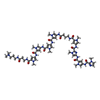



| #6: Chemical | ChemComp-MN / #7: Chemical | #8: Water | ChemComp-HOH / | |
|---|
-Details
| Sequence details | AUTHOR INDICATES ARG-SER DISCREPANCY AT RESIDUE 86 IS A CONFLICT BETWEEN SEQUENCE AND SEQUENCE ...AUTHOR INDICATES ARG-SER DISCREPANC |
|---|
-Experimental details
-Experiment
| Experiment | Method:  X-RAY DIFFRACTION / Number of used crystals: 2 X-RAY DIFFRACTION / Number of used crystals: 2 |
|---|
- Sample preparation
Sample preparation
| Crystal | Density Matthews: 2.65 Å3/Da / Density % sol: 53.62 % | |||||||||||||||||||||||||||||||||||
|---|---|---|---|---|---|---|---|---|---|---|---|---|---|---|---|---|---|---|---|---|---|---|---|---|---|---|---|---|---|---|---|---|---|---|---|---|
| Crystal grow | Temperature: 292 K / Method: vapor diffusion, sitting drop / pH: 6 Details: Manganese chloride, potassium chloride, potassium cacodylate, pH 6.0, VAPOR DIFFUSION, SITTING DROP, temperature 292K | |||||||||||||||||||||||||||||||||||
| Crystal grow | *PLUS Method: vapor diffusion / Details: used macroseeding | |||||||||||||||||||||||||||||||||||
| Components of the solutions | *PLUS
|
-Data collection
| Diffraction | Mean temperature: 100 K |
|---|---|
| Diffraction source | Source:  SYNCHROTRON / Site: SYNCHROTRON / Site:  ALS ALS  / Beamline: 5.0.2 / Wavelength: 1.1 Å / Beamline: 5.0.2 / Wavelength: 1.1 Å |
| Detector | Type: ADSC QUANTUM 4 / Detector: CCD / Date: Jun 28, 2000 |
| Radiation | Protocol: SINGLE WAVELENGTH / Monochromatic (M) / Laue (L): M / Scattering type: x-ray |
| Radiation wavelength | Wavelength: 1.1 Å / Relative weight: 1 |
| Reflection | Resolution: 2.45→60 Å / Num. all: 79809 / Num. obs: 77428 / % possible obs: 97.1 % / Observed criterion σ(F): 0 / Observed criterion σ(I): 0 / Redundancy: 15.7 % / Rmerge(I) obs: 0.107 / Net I/σ(I): 4.2 |
| Reflection shell | Resolution: 2.45→2.49 Å / Rmerge(I) obs: 0.247 / Mean I/σ(I) obs: 2.3 / % possible all: 94.2 |
| Reflection | *PLUS Lowest resolution: 60 Å / Num. obs: 79809 / % possible obs: 98.4 % |
| Reflection shell | *PLUS % possible obs: 94.2 % |
- Processing
Processing
| Software |
| |||||||||||||||||||||||||
|---|---|---|---|---|---|---|---|---|---|---|---|---|---|---|---|---|---|---|---|---|---|---|---|---|---|---|
| Refinement | Method to determine structure:  MOLECULAR REPLACEMENT MOLECULAR REPLACEMENTStarting model: PDB ENTRY 1AOI Resolution: 2.45→60 Å / Cross valid method: THROUGHOUT / σ(F): 2 / σ(I): 2 / Stereochemistry target values: Engh & Huber
| |||||||||||||||||||||||||
| Refinement step | Cycle: LAST / Resolution: 2.45→60 Å
| |||||||||||||||||||||||||
| Refinement | *PLUS Lowest resolution: 60 Å / Rfactor Rfree: 0.258 | |||||||||||||||||||||||||
| Solvent computation | *PLUS | |||||||||||||||||||||||||
| Displacement parameters | *PLUS | |||||||||||||||||||||||||
| Refine LS restraints | *PLUS
|
 Movie
Movie Controller
Controller


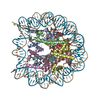
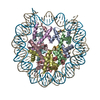
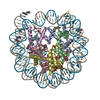
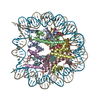
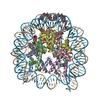
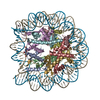
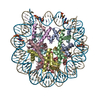


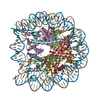
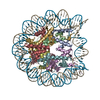
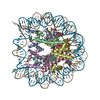
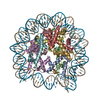
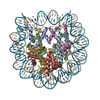
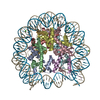
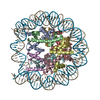
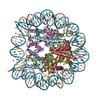
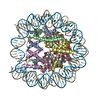
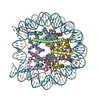
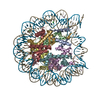
 PDBj
PDBj












































